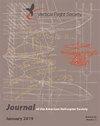旋翼机设计:从概念到机群保障对安全的关键影响第41届亚历山大·a·尼古拉基荣誉讲座
IF 1.4
4区 工程技术
Q2 ENGINEERING, AEROSPACE
引用次数: 0
摘要
我非常荣幸被选中来主持著名的第41届尼古拉基讲座,并有机会综合我的经验,关于航空工程中最重要的原则——“安全概念”。在旋翼领域工作了39年,随着参与和责任的增加,我参与了莱昂纳多直升机部门(LHD)许多直升机模型的设计,开发和认证;如A109、A119、EH101、A129、NH90、AW609等。最近,我全权负责“阿沃家族概念”中的三种新型直升机的设计、开发、认证和投入使用,特别是AW139、AW189和AW169。我非常感谢在我的职业生涯中遇到的导师布鲁诺·洛维拉和桑蒂诺·潘科蒂,他们两人也都获得了尼古拉基讲师奖。在与他们一起工作的过程中,没有一天不提到“安全”这个词。他们告诉我,“安全”应该是每个航空工程师的口头禅,因为这是我们的主要职责和责任,对那些乘坐我们的产品,在我们的产品上工作,每天把他们的生命托付给我们的工作和专业精神。我一直努力不忘记这个教训,并把它传达给我有机会和荣幸一起工作的年轻工程师。如果我能成功地把这一课,通过我与他人的合作,通过这次讲座,这将是我一生中最大的成就。在这方面,本文分为三个部分:(1)定义和原则,以及一些“哲学”概念;(ii)这些原则在莱昂纳多最新一代直升机设计中的应用,最后(iii)对新兴“安全技术”的讨论,这些技术有望提高未来直升机和操作的安全性。本文章由计算机程序翻译,如有差异,请以英文原文为准。
Rotorcraft Design: The Crucial Influence of Safety from Concept to Fleet Support The 41st Alexander A. Nikolsky Honorary Lecture
It is an immense honor to have been selected to hold the prestigious 41st Nikolsky Lecture and to have the opportunity to synthesize my experiences with regards to the most important principle that permeates aeronautical engineering—“the concept of safety.” Having worked in the rotary-wing field for 39 years, with growing levels of involvement and responsibilities, I have been involved in the design, development, and certification of many helicopter models at the Leonardo Helicopters Division (LHD; formerly Agusta and then AgustaWestland), such as A109, A119, EH101, A129, NH90, AW609. More recently, I had the full responsibility of design, development, certification, and entry into service of three new helicopter types within the “AW Family concept”, specifically the AW139, AW189, and AW169. I am profoundly grateful for the mentors encountered in my professional life—Bruno Lovera and Santino Pancotti, both of whom were also honored with the Nikolsky Lectureship. In working with them, not a single day passed where the word “safety” was not mentioned. They taught me that “safety” shall be the mantra of every aeronautical engineer because it is our principal duty and responsibility, towards those who travel in, work on, and work with our products and entrust their lives to our work and professionalism daily. I have tried hard never to forget this lesson, and to convey this to the young engineers that I have had the chance and pleasure to work with. If I have been able to pass on this lesson successfully, through my work with others through this lectureship, it would be the greatest achievement of my life. In this vein, this paper is organized in three parts: (i) definitions and principles, along with some “philosophical” concepts; (ii) the application of these principles at Leonardo in the design of the latest generation of helicopters, and finally (iii) a discussion of emerging “safety technologies” that promise to improve the safety of future helicopters and operations.
求助全文
通过发布文献求助,成功后即可免费获取论文全文。
去求助
来源期刊

Journal of the American Helicopter Society
工程技术-工程:宇航
CiteScore
4.10
自引率
33.30%
发文量
36
审稿时长
>12 weeks
期刊介绍:
The Journal of the American Helicopter Society is a peer-reviewed technical journal published quarterly (January, April, July and October) by AHS — The Vertical Flight Society. It is the world''s only scientific journal dedicated to vertical flight technology and is available in print and online.
The Journal publishes original technical papers dealing with theory and practice of vertical flight. The Journal seeks to foster the exchange of significant new ideas and information about helicopters and V/STOL aircraft. The scope of the Journal covers the full range of research, analysis, design, manufacturing, test, operations, and support. A constantly growing list of specialty areas is included within that scope. These range from the classical specialties like aerodynamic, dynamics and structures to more recent priorities such as acoustics, materials and signature reduction and to operational issues such as design criteria, safety and reliability. (Note: semi- and nontechnical articles of more general interest reporting current events or experiences should be sent to the VFS magazine
 求助内容:
求助内容: 应助结果提醒方式:
应助结果提醒方式:


